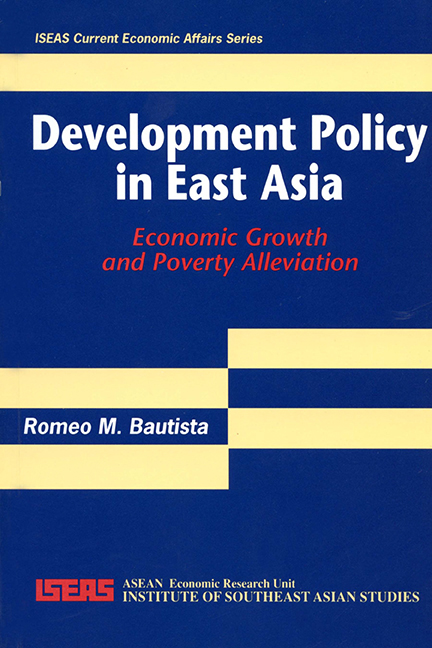Book contents
- Frontmatter
- Contents
- List of Tables
- 1 Introduction
- 2 Measures of Development Performance
- 3 Analytical Considerations
- 4 Economic Conditions in 1965
- 5 Role of Development Policies
- 6 Some General Equilibrium Estimates of Policy Effects
- 7 Redistributive Policies
- 8 Concluding Remarks
- Notes
- Bibliography
- The Author
4 - Economic Conditions in 1965
Published online by Cambridge University Press: 21 October 2015
- Frontmatter
- Contents
- List of Tables
- 1 Introduction
- 2 Measures of Development Performance
- 3 Analytical Considerations
- 4 Economic Conditions in 1965
- 5 Role of Development Policies
- 6 Some General Equilibrium Estimates of Policy Effects
- 7 Redistributive Policies
- 8 Concluding Remarks
- Notes
- Bibliography
- The Author
Summary
Many similarities and differences among the eight East Asian developing economies in the mid-1960s are discernible from Table 4.1.
(l) The comparative values of population density and share of primary commodities in merchandise exports give an indication of the natural resource abundance of the ASEAN-Four countries relative to the NIEs. In 1965 the eight East Asian countries had generally high rates of unemployment and underemployment (Riedel 1988, pp. 15-17), and could be characterized as 1 abour- abundant.
(2) The levels of per capita GNP in 1965 differed widely, as was also the case in 1987 (see Table 2.1), but the rankings among the eight countries were different for the two years. Only Hong Kong, Singapore, and Malaysia exceeded the average per capita GNP of US$260 estimated by the World Bank (Social Indicators of Development 1987) for “low-income economies” in 1965.
(3) Indonesia's per capita GNP of US$30 in 1965 was the lowest not only in East Asia but also among the ninety-three developing countries for which the World Bank (Social Indicators of Development 1987) had available estimates. This has to be viewed in the light of the country's economic stagnation since the early 1950s which began to be reversed only after Soeharto's “New Order” government assumed power in 1966. On the other hand, Hong Kong and Taiwan had a substantial headstart, experiencing rapid growth since the early 1950s.
(4) Excluding the two city states (Singapore and Hong Kong), domestic production was heavily agricultural. Among the six countries, Taiwan and the Philippines had the largest manufacturing contribution to GDP, reflecting their longer history of modern industrialization.
(5) The high ratio of exports to GDP for Singapore and Hong Kong is indicative of the openness of the two economies and their traditional entrepot role. At the other extreme, the small size of Indonesia's export sector in 1965, which shrank almost continuously since the early 1950s (Paauw 1981, p. 151), reflected the lack of growth of the national economy in the previous decade.
- Type
- Chapter
- Information
- Development Policy in East AsiaEconomic Growth and Poverty Alleviation, pp. 20 - 22Publisher: ISEAS–Yusof Ishak InstitutePrint publication year: 1992



